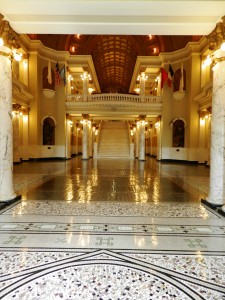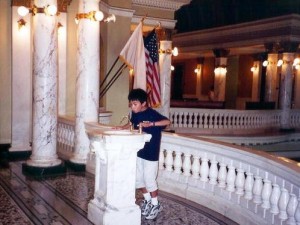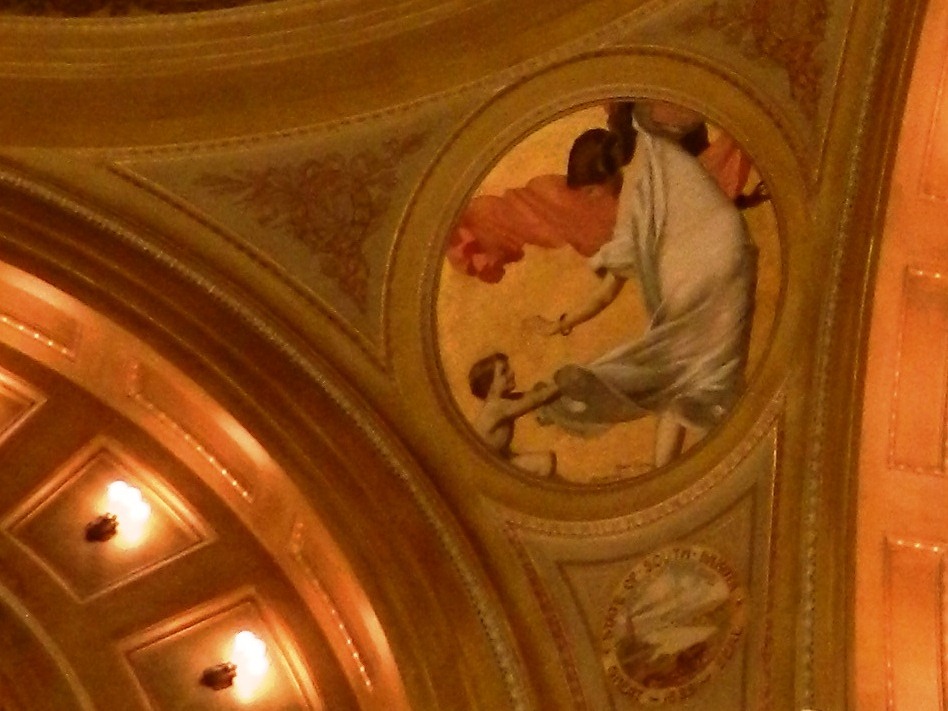» posted on Monday, September 10th, 2012 by Linda Lou Burton
Not A Bad Place To Work
 Linda Burton posting from Pierre, South Dakota – I started snapping pictures the moment I walked in the door; the staircase straight ahead, the hallway to the right; the stained glass overhead; the rotunda, the vault, the murals, the flags, the dazzling terrazzo floor. My eyes could not decide just where to stop. It was light and shiny bright, yet colorful and warm; uplifting, can I use that word? I didn’t know which direction to go first; a young woman approached the elevator by the side of the staircase and I began to ask: Is the gallery open? Can I take the elevator all the way up? What is on the floor below? I realized as I gestured that I had the Self Guided Tour Script of the South Dakota State Capitol under my arm; “Oh, I’m sorry!” I said. “I picked this up at the front door, I should slow down and read it. But everything is so pretty I got overawed.” “I know,” she smiled at me and folded her hands across her tummy; she was pregnant and enveloped with that pregnant glow. “I love working in this beautiful place. I look forward to coming inside every morning.” Quite an endorsement for a building, I’d say.
Linda Burton posting from Pierre, South Dakota – I started snapping pictures the moment I walked in the door; the staircase straight ahead, the hallway to the right; the stained glass overhead; the rotunda, the vault, the murals, the flags, the dazzling terrazzo floor. My eyes could not decide just where to stop. It was light and shiny bright, yet colorful and warm; uplifting, can I use that word? I didn’t know which direction to go first; a young woman approached the elevator by the side of the staircase and I began to ask: Is the gallery open? Can I take the elevator all the way up? What is on the floor below? I realized as I gestured that I had the Self Guided Tour Script of the South Dakota State Capitol under my arm; “Oh, I’m sorry!” I said. “I picked this up at the front door, I should slow down and read it. But everything is so pretty I got overawed.” “I know,” she smiled at me and folded her hands across her tummy; she was pregnant and enveloped with that pregnant glow. “I love working in this beautiful place. I look forward to coming inside every morning.” Quite an endorsement for a building, I’d say.
 We parted company after a bit; I went up a floor and found a bench; sat down to read that self-guided script. I’m sitting near one of the marble water fountains, really beautiful creations; an open seashell design; when they were installed a brass cup and a bowl of fresh water were put out each day for the comfort of visitors and employees. Later, when running water was available in the building, the solid brass spigots and handles were added. They’re a little tall, requiring tippy-toes for some.
We parted company after a bit; I went up a floor and found a bench; sat down to read that self-guided script. I’m sitting near one of the marble water fountains, really beautiful creations; an open seashell design; when they were installed a brass cup and a bowl of fresh water were put out each day for the comfort of visitors and employees. Later, when running water was available in the building, the solid brass spigots and handles were added. They’re a little tall, requiring tippy-toes for some.
 A closer view of the rotunda here; Victorian leaded stained glass in a majestic curve, the top, I read, is 96 feet from the floor. Sixteen openings represent the Tree of Life; the bottom ring represents eternity. Flags hang high, the flags of the United States, Spain, France, the Dakota Territory. Other significant flags are the blue South Dakota state flag, the white flag of the United Sioux tribes; the eagle staff, the first flag used by Native Americans as they traveled across the Great Plains. It is wrapped with smoked buffalo hide and strung with beads and eagle feathers over green willow branches.
A closer view of the rotunda here; Victorian leaded stained glass in a majestic curve, the top, I read, is 96 feet from the floor. Sixteen openings represent the Tree of Life; the bottom ring represents eternity. Flags hang high, the flags of the United States, Spain, France, the Dakota Territory. Other significant flags are the blue South Dakota state flag, the white flag of the United Sioux tribes; the eagle staff, the first flag used by Native Americans as they traveled across the Great Plains. It is wrapped with smoked buffalo hide and strung with beads and eagle feathers over green willow branches.
Colors have great meaning, I read. Plains Indian tribes used colors to represent the seven directions; white is north – the direction from which snow comes; red is east – the rising sun. Yellow is south – from which the sun shines. Black is west – the direction from which thunder comes. Blue stained glass is sky. Green terrazzo tiles are green grass. Finally, representing “where you are,” a brass triangle is placed in the center of the rotunda floor. I moved downstairs to find that center-of-the-universe spot.
 From there, I have a clear view of the murals; four of them, done in 1910. Female figures depict the major interests of the people of South Dakota – love of family, and love of state. Mythical goddesses; there is Ceres, representing agriculture, with stalks of corn; below is the great seal of the United States. There is Europa, representing livestock; underneath is the seal of France, as the land that is South Dakota was part of the Louisiana Purchase from France. There is Minerva, operating a steam drill, representing wisdom, industry and mining; underneath is the seal of Spain, recognizing that the land that is the United States was ‘discovered’ by Columbus in 1492.
From there, I have a clear view of the murals; four of them, done in 1910. Female figures depict the major interests of the people of South Dakota – love of family, and love of state. Mythical goddesses; there is Ceres, representing agriculture, with stalks of corn; below is the great seal of the United States. There is Europa, representing livestock; underneath is the seal of France, as the land that is South Dakota was part of the Louisiana Purchase from France. There is Minerva, operating a steam drill, representing wisdom, industry and mining; underneath is the seal of Spain, recognizing that the land that is the United States was ‘discovered’ by Columbus in 1492.
Above the seal of the state of South Dakota is the last mural I see; it is “Motherhood,” Venus and Cupid, a child clinging to the draperies of its mother, representing love of family. The artist, Edward Simmons, said of this painting, “this is the best thing I have done in my long life of busy artistry.”
Not a bad place to work, I’m thinking. That mommy-to-be was right.
About the history of the South Dakota State Capitol http://www.state.sd.us/boa/CapitolTour/completedcap.htm
 Note: I spotted one of the legendary blue tiles as I walked towards the back of the building to leave. The story goes that 66 Italian artists were hired to lay the terrazzo tile flooring in the new capitol building. Each artist was given a special blue stone they could place somewhere in the capitol at their discretion; it was their “signature stone.” Only 57 of the 66 have ever been found.
Note: I spotted one of the legendary blue tiles as I walked towards the back of the building to leave. The story goes that 66 Italian artists were hired to lay the terrazzo tile flooring in the new capitol building. Each artist was given a special blue stone they could place somewhere in the capitol at their discretion; it was their “signature stone.” Only 57 of the 66 have ever been found.

